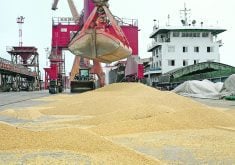China accounted for 28 per cent of global food consumption growth in the last decade, but that could fall to 11 percent
SASKATOON — India, Southeast Asia and Sub-Saharan Africa are displacing China as drivers of agricultural markets, according to a new report.
The paper, jointly released by the United Nations’ Food and Agriculture Organization (FAO) and the Organization for Economic Co-operation and Development (OECD), states that a “notable shift” is expected over the coming decade.
China accounted for 28 per cent of the growth in global consumption of agriculture and fisheries products over the previous decade, but its share of additional demand over the coming decade is projected to fall to 11 per cent.
That is due to China’s declining population, slower income growth and a stabilization of nutrition levels in that country.
Other countries and regions will displace China as key drivers of agricultural markets in the coming decade.
“India and Southeast Asian countries are projected to account for 31 per cent of global consumption growth by 2033, driven by their growing urban population and increasing affluence,” stated the report.
Sub-Saharan Africa is forecast to account for another 18 per cent of the growth in global consumption, due primarily to population growth.
Markets Farm analyst Bruce Burnett said the report needs to be put in context for Canadian growers and exporters.
“China is our largest customer, and I would suspect that they will remain the largest customer for the foreseeable future,” he said.
However, the rise of India is interesting and could influence what western Canadian farmers grow in the future.
India is a large pulse market and is also the world’s largest oilseed buyer, so there could be further opportunities for peas, lentils and canola in that market. It also has years when it is short of wheat.
“For some of our crops, we’re probably going to be very competitive into there,” he said.
The same goes for other regions mentioned in the FAO/OECD report.
Canada enjoys logistical advantages compared to some competitors servicing the Chinese market. However, many markets in Southeast Asia are as accessible as China.
“For Sub-Saharan Africa, we’re reasonably competitive into those areas through our east coast system,” he said.
The report estimates that global food consumption is projected to increase by 1.2 per cent annually over the next decade.
In response, global cereal production is projected to rise 350 million tonnes to 3.2 billion tonnes by 2033.
World cereal trade is anticipated to grow by 16 per cent to 551 million tonnes, which is slow compared to the previous decade.
Russia is projected to maintain its position as the world’s largest wheat exporter, with a 26 per cent market share by 2030.
“The United States will surpass Brazil and become the primary (corn) exporter, while the European Union will continue as the main exporter of other coarse grains,” stated the report.
The OECD-FAO outlook is forecasting that the current trend of declining cereal prices will persist until 2033.
The ongoing downward adjustment of oilseed prices is expected to continue during the first few years of the outlook. Thereafter, prices will increase slightly in nominal terms.
Per capita consumption of vegetable oil is expected to decline slightly (-0.2 per cent) due to reduced food demand in high-income countries.
Biodiesel/renewable diesel use is expected to increase by 1.3 per cent per year over the next 10 years, compared to a 6.8 per cent annual increase over the last decade.
“In general, national targets for mandatory biodiesel consumption are expected to increase less than in previous years,” stated the report.
Soybean crush is projected to expand by 49 million tonnes over the outlook period, which would be significantly less than the 65 million tonnes over the previous decade.
Soybean production is expected to grow by 0.8 per cent per year, compared to two per cent over the last decade.
The production of other oilseeds, such as canola, sunflower and groundnuts, will also grow at a slower pace of 0.8 per cent per year, compared to 2.9 per cent.
Canada’s canola production is projected to increase by 1.1 per cent per year, reaching 21 million tonnes by 2033.
Palm and canola yields have either fallen or grown slowly during the last decade due to the ageing of oil palms, acreage expansion happening on marginal land, restrictions in pesticide use and shifting weather patterns.
Burnett said the FAO/OECD demand outlook seems too bearish, especially for oilseeds.
“I do agree that in developed countries, they’re going to drop consumption, but I don’t see any stopping the growth in those other countries, especially Southeast Asia and India,” he said.
He also believes the organizations are being too cautious about vegetable oil demand from the biodiesel and renewable diesel sectors.
“The energy costs are not insignificant right now,” he said.
“That could certainly boost renewable diesel demand.”
Read Also

Volatile temperatures expected for this winter
DTN is forecasting a lot of temperature variability in the Canadian Prairies this winter. Precipitation should be close to average.
















